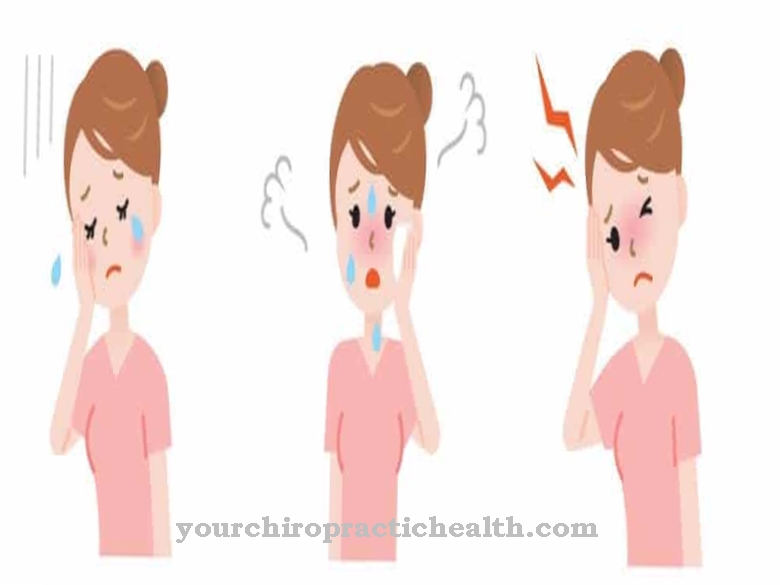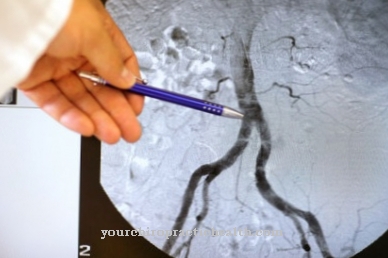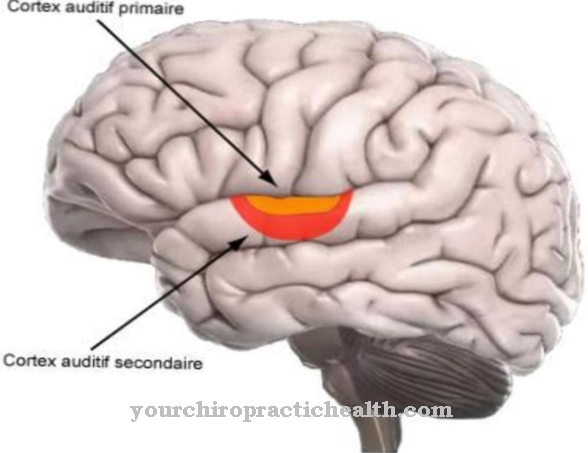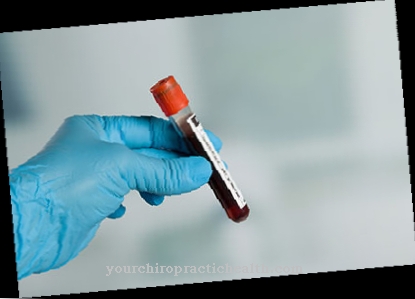Tonsillar angina should not be confused with the symptom of tonsillitis, even if this is associated with the angina present. Angina tonsillaris is also to be differentiated from angina pectoris, which only seems to be related in name. Other terms are Acute tonsillitis, acute tonsillitis or just angina.
What is tonsillar angina?

Tonsillar angina is inflammation of the tonsils. It mainly affects school children, very rarely toddlers. The problem is that tonsillar angina (short angina called) can be very painful. Every swallowing movement causes discomfort and the intake of food is difficult. This can lead to weight loss and physical exhaustion.
Without proper treatment, the disease spreads quickly. Then there is also a fever and often the patient feels so sick that a drop in performance, e.g. in school is the result. Because speaking is also difficult, and when tonsillar angina spreads to the vocal cords, the voice is temporarily completely absent. Participation in school lessons is then no longer possible and bed rest is also included in tonsillar angina high fever makes sense.
causes
The cause of tonsillar angina are mainly bacteria, namely the streptococci. These bacteria are found on the skin and in the intestines. They are involved in many infections. A distinction must be made between these bacteria and their ability to break down blood (alpha, beta and gamma hemolysis). It is particularly easy to get infected where many people meet.
As soon as a person coughs, a multitude of bacteria buzz through the air and are passed on from person to person. It is also easy to get infected through handles, for example on buses and trains, as the bacteria occur more often there and are resistant. A healthy person with sufficient defenses is usually not burdened or infected.
But if the immune defense is weakened by factors such as too little sleep and too much negative stress, the bacteria have an easy time and the angina tonsillaris spreads quickly. Chronic tonsillar angina is usually a mixed infection, i.e. both anaerobic and aerobic pathogens.
The swelling of the tonsils is also caused by this pathogen. Drafts in the train or bus can also weaken the immune system so much that infection is easily possible.
Symptoms, ailments & signs
The symptoms of acute and chronic forms of tonsillar angina differ from one another. Acute tonsillitis is characterized by increasing pain in the throat. When swallowing, yawning and otherwise opening the mouth, the pain can radiate into the ears. In addition, there is often a high fever, headache and fatigue.
The voice is thick and there is increased salivation. Examination of the tonsils reveals that they are red, swollen, and often pus. If acute tonsillar angina is not treated, the ever increasing swelling of the tonsils can cause shortness of breath. Children especially suffer from this because their tonsils are already enlarged in a healthy state.
After one to two weeks, the acute tonsillitis usually heals without consequences. Chronic tonsillar angina may develop after frequent tonsillitis. There are usually slight swallowing difficulties here. A persistent, unpleasant bad breath is typical. Often the cervical lymph nodes are permanently swollen. However, this swelling does not cause pain.
Many of those affected suffer from a reduced ability to perform and concentrate. In addition, dead tissue (detritus) is discovered on the tonsils, which decomposes and causes the unpleasant bad breath. Angina tonsillaris can also lead to complications such as rheumatic fever, heart muscle inflammation, joint inflammation, skin rashes, kidney inflammation or even sepsis.
course
The course of tonsillar angina often begins with harmless swallowing difficulties. The infected person then notices that both drinking and eating cause discomfort. Often the consumption of food is then reduced, which means an additional weakening of the immune system. The tonsils swell quickly and a high fever occurs, so that the patient feels tired and exhausted.
When the almonds are festered, there is strong bad breath. The lymph nodes swell. This causes additional pain. Since the disease is contagious, the infected person should not come too close to others. Otherwise it is to be feared that other members of the family or school class will become infected and re-infected and infect each other.
Complications
As a complication of tonsillitis, an abscess can form in the area of the tonsils or the back of the throat. This creates a swelling in which pus collects. Pain and fever indicate the development of an abscess. In rare cases, the causative agents of tonsillar angina can be carried through the bloodstream throughout the body and thus trigger sepsis.
This complication manifests itself as a high fever and a significant deterioration in the general condition. Sepsis is a potentially life threatening condition. Other possible sequelae of tonsillitis are caused by the infestation of the heart by the pathogens. Inflammation of the heart muscle (myocarditis), the lining of the heart (endocarditis) or the pericardium (pericarditis) occurs.
Possible consequences can be a weak heart or cardiac arrhythmia. Acute rheumatic fever can occur up to three weeks after tonsillitis, especially in children and adolescents. It is a systemic disease that affects the joints, skin, heart and brain. Inflammation occurs in the heart and joints.
Rheumatoid nodules appear on the skin. The involvement of the brain triggers uncontrollable movements. The causative agents of tonsillitis can cause glomerulonephritis. This inflammation of the kidney corpuscles manifests itself, among other things, by decreased urine output, edema and increased blood pressure.
When should you go to the doctor?
Tonsillar angina or tonsillitis is a disease that often occurs in connection with various infections of the upper respiratory tract and usually has a good prognosis even without medical treatment. Often, as with the classic cold and other cold symptoms, simply rest and a sufficient amount of water and the familiar home remedies help to get well again. A visit to the doctor is therefore usually not necessary for adults or children in the case of angina tonsillaris without complications.
It is only advisable to see a doctor if the tonsillar angina does not resolve after a few days. The same applies if tonsillitis is associated with severe pain, which in a child, for example, leads to consistently refusing to eat. A high fever, accompanying severe headache or a strong cough are also reasons to visit a doctor in order to have a possible flu, bronchitis or pneumonia diagnosed and treated at an early stage because of the somewhat poorer prognosis.
Almonds actually have a barrier function, as they protect the lower respiratory tract from pathogens. Sometimes the tonsils are very fissured due to recurring inflammation and are then no longer able to exercise their natural defense function. On the contrary: they are often the starting point for bacteria and viruses, which can lead to chronic inflammation. Here, too, a visit to the doctor is advisable to discuss a possible removal of the tonsils.
Doctors & therapists in your area
Treatment & Therapy
The treatment is a precise evaluation by the doctor, whether it is an acute tonsillar angina or an advanced tonsillar angina with purulent tonsils and very high fever. To do this, the doctor takes a throat swab to determine the number of steptococci ascertain. The further treatment depends on this.
If the number of streptococci is low, a simple throat spray or throat lozenge is sufficient to relieve the symptoms. Also throat rinses to gargle are useful. Cold and damp neck compresses also help against both the sore throat and the fever. If tonsillar angina has progressed, it may be necessary to take antibiotics and keep strict bed rest so that the body can regenerate.
When antibiotics are given, care should be taken that they can have side effects. These include diarrhea, which can be remedied with a bland diet. Whenever possible, those infected with tonsillar angina should not eat fatty foods. Light meals with rice and vegetables and sufficient fluid intake allow the patient to recover quickly.
Aftercare
In most cases of tonsillar angina, follow-up care options are very limited. The patient is primarily dependent on medical treatment, as this disease does not heal itself and the possibilities for self-help are only very limited. However, tonsillar angina does not reduce life expectancy.
The treatment of tonsillar angina is mostly done with the help of antibiotics. Those affected should ensure that they take the medication regularly and that they may interact with other drugs. When taking antibiotics, alcohol should also not be consumed, as this weakens the effect of the antibiotics.
In the case of children, parents in particular must ensure that the medication is taken correctly and regularly. To counteract diarrhea, those affected should drink plenty of fluids and take it easy on the stomach. Only light food is recommended during tonsillar angina. After the disease has healed, the stomach can be used to the usual food again. In most cases the disease progresses positively.
Outlook & forecast
Angina tonsillaris is a common disease that can vary in severity. As a rule, it is uncomplicated and, with the right treatment, heals completely within a short time: after the administration of antibiotics, the healing process takes about two weeks. Only in rare cases do the inflamed tonsils swell so much that they impede breathing. In this case, it is imperative to visit a doctor again.
In order not to hinder healing, care should be taken to ensure adequate fluid intake (preferably in the form of water and unsweetened tea) and soft food. Neck wraps and lozenges can also relieve existing symptoms such as a sore throat and difficulty swallowing.
Acute tonsillitis can turn into a chronic form. Most of the symptoms are reduced. Only the lymph nodes remain swollen. In addition, many sufferers suffer from mild, persistent malaise. Chronic tonsillitis can also have a negative impact on other organs: it can lead to accumulations of pus in the throat area, kidney and heart damage and inflammation of the joints. In some cases, it makes sense to remove the tonsils. This surgical procedure is not a problem in adulthood.
You can do that yourself
The tonsillar angina with its inflamed tonsils should always be treated by a doctor. As part of the medical treatment, a throat swab can be used to examine whether the infection is bacterial or viral. Complete bed rest is recommended to aid recovery from tonsillar angina. Although swallowing is often painful, people should drink enough fluids. Lozenges and mouthwashes can reduce pain and promote healing.
Numerous home remedies have proven effective for tonsillar angina. Envelopes with quark or mixed healing earth are particularly often used, as these have an anti-inflammatory effect. Your own well-being should decide whether the compress should be used cold or warm. A cold compress stimulates the mucous membrane and thus provides relief from the symptoms. A warm compress, on the other hand, has a warming effect and promotes blood circulation. Another tried and tested remedy is a fresh ginger tea with honey and lemon.
If tonsillar angina is accompanied by a high fever, calf wraps are recommended. Consuming cold drinks or ice cream can relieve swallowing discomfort. Since smoking can worsen the symptoms, active smoking should be avoided during the inflammation.

.jpg)




.jpg)









.jpg)







.jpg)



